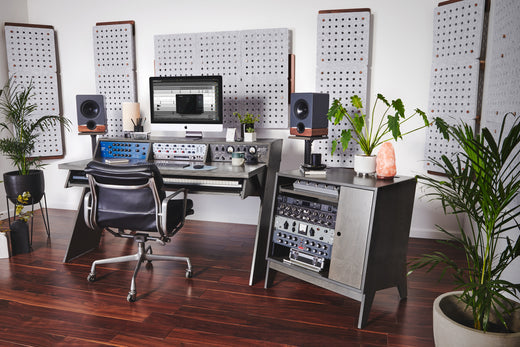We here at De-Fi have a background in making complex electronic instruments. There are universal product development disciplines we’ve used throughout our careers that we’ve taken into furniture design, and the user story is foundational to this discipline (more here). In this ongoing series we’re going to explore actual user stories that we created based on feedback, and how they drove development.
The following is verbatim from the updated Platform Studio Desk’s specification:
- I only own a couple of pieces of gear that require a rack, I’d like to be able to rack that gear and not have the empty spaces seem like I’m missing something, and be usable for other gear but not get in the way of my workflow.
This story was a carryover from the original Platform, with the addition in italics.
One of the frustrations we had with studio desks on the market when we designed Platform, was having worthless holes if the entire desk wasn’t racked. In this era of good DSP and in the box production, it’s not a given that everyone who wants a nice looking studio desk is going to have, or really even need 9U’s of outboard gear. While ending the desktop at the racks does allow you to angle the racks, it doesn’t allow you to do much else, therefore we decided to extend the desktop.
This allows for a much more flexible desk, because you can store gear you aren’t using, put hard drives, gear with top mounted controls, laptops etc. all under the bridge while still being able to rack some gear in different sections.
However, when studying feedback and doing design studies of the original desk, we found we overshot it a bit when we extended it beyond the back of the desk to hang the cable management off of. We found that after about 8” of depth, the only thing that users had back there was cables attached either to the gear in front of it, or cables just sitting there, basically acting as a cable deck. The reason the back of the desktop was becoming a de facto cable deck was you couldn’t reach the actual cable deck from the front of the desk. Visible cables not being connected to something on the same tier is kind of a no-no in our anti visual clutter ethos, which is why we made the addition to the user story about not impeding workflow. The difficult access to the original cable deck also had some folks just having cables falling off the back of the desktop, avoiding it entirely, which hurt our design hearts.
Our solution to the problem and satisfying the user story was to move the cable deck from hanging off the back of the desk to further forward in between the legs, deepening it–making it larger, and shortening the back the of the desktop, putting all cables into a larger hidden tier that you can access by reaching through the rack sections (assuming the section isn’t racked). Even if sections are racked, you can still more easily get access to the cable deck by reaching around the nook in the X of the legs without having to negotiate all of the standoffs attaching the old design. We’re using the same amount of material, we’re just using it in different places.
That said, we still needed a usable depth to the desktop, so we went with 7.5” of extension under the bridge (measured from the front of the bridge) because that will accommodate most laptops, hard drives, tabletop synths, or top controlled audio interfaces–basically, gear we knew people were using that space for. As a bonus, it increases air flow for any racked gear. We also added some cutouts in the wood to corral any cables hanging off the back of the desktop to the cable deck below.


While we were admittedly a bit nervous about this change because it was a bit more esoteric, we felt strongly enough about the improvement to actual workflow and function that we went for it, and have received a lot of positive feedback from those who have purchased the updated Platform. We took a desk that had the best cable management in the business, and made it better.


